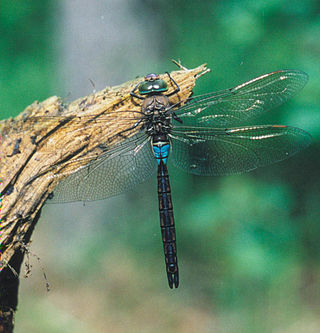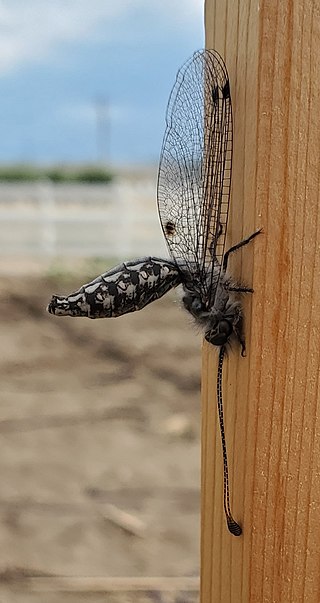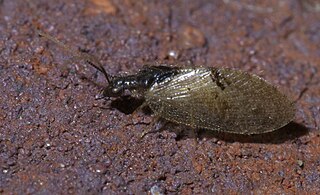
The insect order Neuroptera, or net-winged insects, includes the lacewings, mantisflies, antlions, and their relatives. The order consists of some 6,000 species. Neuroptera is grouped together with the Megaloptera and Raphidioptera (snakeflies) in the unranked taxon Neuropterida.

Green lacewings are insects in the large family Chrysopidae of the order Neuroptera. There are about 85 genera and 1,300–2,000 species in this widespread group. Members of the genera Chrysopa and Chrysoperla are very common in North America and Europe; they are very similar and many of their species have been moved from one genus to the other time and again, and in the nonscientific literature assignment to Chrysopa and Chrysoperla can rarely be relied upon. Since they are the most familiar neuropterans to many people, they are often simply called "lacewings". Since most of the diversity of Neuroptera are properly referred to as some sort of "lacewing", common lacewings is preferable.

Scutelleridae is a family of true bugs. They are commonly known as jewel bugs or metallic shield bugs due to their often brilliant coloration. With the name based on the Asian genus Scutellera, they are also known as shield-backed bugs due to the enlargement of the thoracic scutellum into a continuous shield over the abdomen and wings. This latter characteristic distinguishes them from most other families within Heteroptera, and may lead to misidentification as a beetle rather than a bug. These insects feed on plant juices from a variety of different species, including some commercial crops. Closely related to stink bugs, they may also produce an offensive odour when disturbed. There are around 450 species worldwide.

Ascalaphidae is a family of insects in the order Neuroptera, commonly called owlflies; there are some 450 extant species. They are fast-flying crepuscular or diurnal predators of other flying insects, and have large bulging eyes and strongly knobbed antennae. The larvae are ambush predators; some of them make use of self-decoration camouflage.

Hemerobiidae is a family of Neuropteran insects commonly known as brown lacewings, comprising about 500 species in 28 genera. Most are yellow to dark brown, but some species are green. They are small; most have forewings 4–10 mm long. These insects differ from the somewhat similar Chrysopidae not only by the usual coloring but also by the wing venation: hemerobiids differ from chrysopids in having numerous long veins and forked costal cross veins. Some genera are widespread, but most are restricted to a single biogeographical realm. Some species have reduced wings to the degree that they are flightless. Imagines (adults) of subfamily Drepanepteryginae mimic dead leaves. Hemerobiid larvae are usually less hairy than chrysopid larvae.

The dustywings, Coniopterygidae, are a family of Pterygota of the net-winged insect order (Neuroptera). About 460 living species are known. These tiny insects can usually be determined to genus with a hand lens according to their wing venation, but to distinguish species, examination of the genitals by microscope is usually necessary.

Anax is a genus of dragonflies in the family Aeshnidae. It includes species such as the emperor dragonfly, Anax imperator.

Chrysoperla is a genus of common green lacewings in the neuropteran family Chrysopidae. Therein they belong to the Chrysopini, the largest tribe of subfamily Chrysopinae. Their larvae are predatory and feed on aphids, and members of this genus have been used in biological pest control.

Chrysopinae is the nominate subfamily of green lacewings in the insect family Chrysopidae in the order Neuroptera. This subfamily is also the largest within the family and comprises about 60 genera.

Chrysoperla carnea, one of the species of common green lacewing, is an insect in the Chrysopidae family. Although the adults feed on nectar, pollen and aphid honeydew, the larvae are active predators and feed on aphids and other small insects. It has been used in the biological control of insect pests on crops.

Chrysopa perla, the Pearly Green Lacewing, is an insect species belonging to the green lacewing family, Chrysopidae.

Chrysopini is a tribe of green lacewings in the family Chrysopidae. There are about 32 genera and 926 described species in Chrysopini.

Ululodes is a genus of owlflies in the tribe Ululodini. There are at least 27 described species in Ululodes.

Odontoceridae is a family of mortarjoint casemakers in the order Trichoptera. There are about 12 genera and at least 100 described species in Odontoceridae.
Sympherobius californicus is a species of brown lacewing in the family Hemerobiidae. It is found in Central America, North America, and Oceania. The species was introduced to New Zealand to prey on aphids and mealybugs affecting crops, first noted in 1936, however was not able to be established.

Sympherobius barberi, or Barber's brown lacewing, is a species of brown lacewing in the family Hemerobiidae. It is found in Europe and Northern Asia, Central America, North America, Oceania, and South America. The species was introduced to New Zealand to prey on aphids and mealybugs, first noted in 1936, however was not able to be established.

Chrysoperla rufilabris, also known as the red-lipped green lacewing, is a species of green lacewing in the family Chrysopidae.

Chrysopa oculata is a species of green lacewing in the family Chrysopidae. It is found in North America and Central America. This species was imported to New Zealand in 1926, as a way to control aphid populations, however did not establish in the country.

Mallada basalis is a species of green lacewing in the family Chrysopidae, first described by Francis Walker in 1853. No subspecies are listed in the Catalog of Life. The species was detected on mainland New Zealand in the 2010s.

Drepanacra binocula, known as the Australian variable lacewing, is a species of brown lacewing in the family Hemerobiidae, found across Australia and New Zealand, including Lord Howe Island, Norfolk Island and the Kermadec Islands.

















